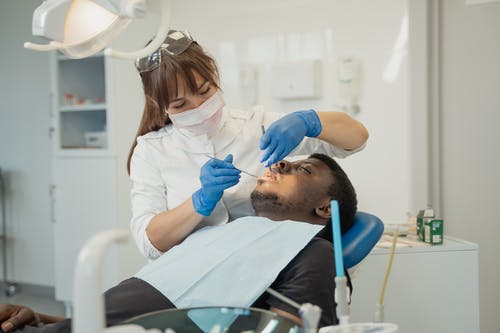
What is the Process of Tooth Extraction, and When is it Necessary?
Extracting a tooth involves having it removed from your mouth. This might sound serious, but it’s a standard process that’s done in a dentist’s office. There could be all sorts of reasons why you have this done. You might have damaged your tooth, or maybe the dentist needs to make space for other teeth to keep them healthy.
In today’s article, we’re going to talk all about this process. We’ll look at why it needs to be done, how it’s done, and what happens after a tooth is extracted. So, let’s dive in and learn all about tooth extractions.
The Process of Tooth Extraction
Did you know there’s more than one way to extract a tooth? That’s right! The type of extraction you get usually depends on the problem at hand. Let’s take a look at some procedures.
- Dental Surgery: If a tooth is difficult to remove, you might need to have surgery. The dentist makes a small cut into your gum, gently removes the tooth, and often takes away some of the bone around it. It may sound scary, but it’s a common procedure. It’s also done under local anesthesia, so you don’t feel any pain.
- Wisdom Tooth Removal: Sometimes, people’s wisdom teeth don’t come out completely. That makes them hard to reach. In such a case, the dentist performs a surgical extraction. They might even need to remove some bone.
- Extraction Recovery: After your tooth is extracted, you need to rest and take care of the extraction spot. This is known as recovery. How long the recovery period lasts depends on different things. These include your overall health and how complex the extraction was. When you have your tooth extracted in Owings Mills, MD, the dentist will give you lots of advice on how to take care of the extraction spot. This advice helps you recover faster.
Why We Need Tooth Extraction
There’s usually a critical reason why a dentist suggests extracting a tooth. It is a serious decision, so they won’t suggest it unless it’s necessary. Let’s discuss some situations where this procedure is required.
- Dental Overcrowding: When teeth don’t have enough space to grow properly, they can overlap each other. They might even push each other out of position. This causes them to become crooked. The dentist might remove one or more teeth to create space. This improves the alignment of the remaining teeth and makes it easier to keep them clean.
- Risk of Infection: Did you know your teeth can become infected? If you have a weak immune system due to chemotherapy or organ transplants, even a risk of infection is a big deal. In this case, the dentist may have to extract the tooth to prevent any such infection.
About Dental Botox
When I mention Botox, you probably think of it as a treatment to remove wrinkles. But that’s not the only use of Botox! It’s also being used in dentistry. Botox is simply a drug that when injected into a muscle, stops the muscle from tightening. This can help with many dental problems. Let’s look at a few examples.
- Botox for TMJ: Your temporomandibular joint (TMJ) is the hinge that connects your jaw to the temporal bones of your skull. If this joint is troubled, it can cause pain in your jaw, and in the muscles that move your jaw. Botox can help with that by keeping these muscles relaxed.
- Botox for Facial Pain: Some folks face pain in their jaw, neck, or face. These pains can range from moderate to severe. Doctors can use Botox to relax the muscles causing this pain.
- Therapeutic Botox: Did you know Botox can also be used as a non-surgical treatment? Therapeutic Botox is used to treat chronic (long-lasting) facial pain conditions. It also treats bruxism (grinding or clenching of teeth) and TMJ disorders. Dentists aim to provide exceptional dental Botox treatment options, using Botox in therapies that can help improve the patient’s quality of life.
Periodontitis is a Serious Gum Disease
Another term you might hear at the dentist’s office is periodontitis. It’s a severe form of gum disease that comes from untreated gingivitis. What happens is that a layer of bacteria, called plaque, builds up on your teeth. This hardens and aggravates your gums, causing inflammation.
- Gum Disease: If periodontitis goes untreated, it can cause chronic inflammation (long-lasting swelling) and severe oral issues. These can include loss of teeth.
- Oral Hygiene: Good oral hygiene is the key to preventing periodontitis. Brushing your teeth twice a day, flossing, and regular dental cleanings can help fend off this gum disease.
- Scaling and Root Planing: These treatments for periodontitis are standard. They help remove plaque and tartar that has built up both above and below the gum line. Root planning also smoothens out your teeth roots. Anyone getting treated by a periodontist in Owings Mills for gum treatment can get these treatments done. They help fight periodontitis effectively and make the patient’s gums healthier.
In Conclusion
We’ve learned a lot today! The goal of a dentist when performing a tooth extraction in Owings Mills, MD is to maintain your oral and overall health. Modern medicine and technologies make this a safe and effective process. As patients, we should regularly visit our dentists and focus on maintaining our oral hygiene to prevent diseases like periodontitis.
Dental Botox is progressing and being used in both therapeutic and aesthetic dentistry to manage facial pain and provide cosmetic benefits. Remember, the key to a healthy, bright smile is regular dental care. So, let’s all pledge to take care of our teeth!

